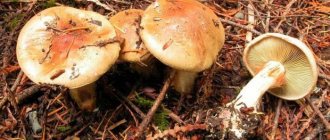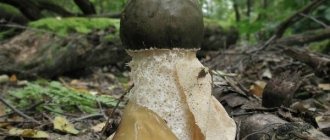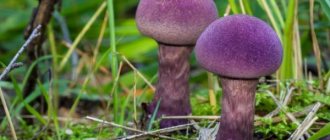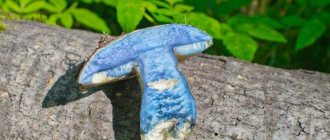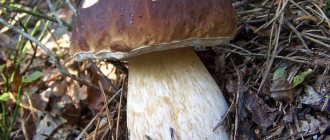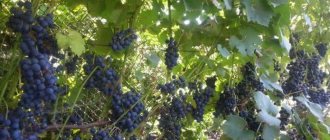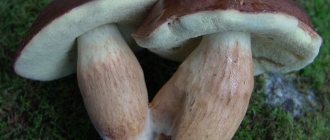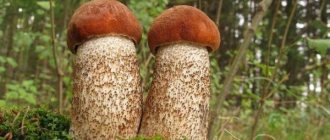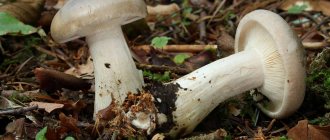Purple cobweb is a very rare, but extremely beautiful species, which is listed in the Red Book. Belongs to the genus Lepista, a subspecies of the Buttercup family. Little known in our country.
This is a conditionally edible mushroom, although due to its unusual appearance, there are not so many daredevils who are ready to dare to try it. But those who know how to distinguish cobwebs from poisonous species and cook them correctly claim that its pulp is very tasty. Today we will look at the features of this mushroom, its beneficial properties and possible harm.
What is the purple cobweb mushroom?
To begin with, you should pay attention to the description of the appearance of this unusual representative of the fungal kingdom (Figure 1).
The diameter of the cap of the purple cobweb can grow up to 16 cm. In a young specimen, the shape of the cap is spherical. Then, over time, it straightens and becomes flat, with a tubercle in the center. The color of the cap of a young mushroom is deep purple, in rare cases it may have a reddish tint. Its surface is fibrous, like velvet. The lower part has wide plates of the same purple color.
Figure 1. The appearance of the spider web is very unusual due to its rich purple color
The leg has an elongated shape, widened downwards, the same color as the cap. If you look closely, you can see what looks like a painted web on the leg. Perhaps for this reason the mushroom acquired such an original name.
In fact, the mushroom is very fragile, so it must be carefully cut so as not to damage it. The pulp has a soft blue tint. The smell is barely noticeable. Does not have particularly high taste qualities.
Edible or not
We have already mentioned above that the purple cobweb is classified as conditionally edible. This means that it can be eaten only after careful heat treatment. But even in this case the taste will be very mediocre.
However, it is believed that the pulp contains many useful substances and vitamins. Most edible mushrooms, including spider webs, contain many vitamins, micro and macroelements, carbohydrates, proteins, fiber, amino acids, essential oils, enzymes, stearic acid and ergosterol.
Note: Among the vitamins in the pulp of the spider web are A (retinol), all vitamins of group B, PP and D. There are also quite a lot of macro- and microelements: potassium, calcium, phosphorus, iron, iodine, zinc, manganese and sulfur.
How does this affect the human body? Due to its composition, the spider web has:
- Anti-inflammatory effect and the ability to strengthen the human immune system.
- Reduces blood cholesterol levels.
- Positively affects mental activity.
- Strengthens the nervous system, helping to fight stressful situations and depression.
- Promotes weight loss as it is low in calories.
In addition, dishes made from this mushroom have a positive effect on the condition of hair and skin, prevent fatigue, lower blood sugar levels, and are therefore recommended for people with diabetes.
Mycological characteristics
The violet cobweb mushroom is an edible species from the family Cortinariaceae of the order Agaricaceae.
External description is given in the table:
| hat | Width up to 15 cm. The shape is convex, as the fungus develops it becomes like a pillow; in overgrown specimens it takes on a prostrate appearance, retaining a mound in the central part. The edges are uneven, wavy, the structure is felt, scaly. The color is initially a contrasting purple, but fades over time. |
| Hymenophore | It is formed by wide, sparsely spaced plates, which are attached with teeth to the stem. The color is dark purple. |
| Mushroom leg | Height up to 12 cm, thickness up to 2 cm. The upper part is scaly. The base is thickened and resembles a tuber, the surface is fibrous, covered with the remains of a spider web. The structure is dense. The color is purple with a brown or dark tint. |
| Pulp | Thick and fleshy, fragile, breaks easily. The color is white-gray, white-blue or with a violet-gray tint. The taste is not pronounced, close to nutty. There is practically no smell. |
| Reproduction | It reproduces by spores of average size 16*9 microns, having an almond shape and a warty surface. The spore powder is brown or rusty-ochre. |
Description and photo
The spider web is listed in the Red Book, so its mass collection is not practiced. In addition, due to its unusual appearance, not every person dares to try this mushroom, for fear of confusing it with a toadstool (Figure 2).
Figure 2. The easiest way to learn to distinguish this mushroom is from a photo
In fact, this mushroom is conditionally edible, but most mushroom pickers prefer to avoid it. The fact is that there is liability for the destruction of plants and mushrooms listed in the Red Book. In addition, there is a high risk of confusing the spider web with its poisonous counterpart and getting poisoned.
In which regions is the mushroom listed in the Red Book?
The ability of the marsh plant to form mycorrhiza with different trees gives it the opportunity to grow almost anywhere in the world. Despite this, the mushroom is quite rare, which is why in many regions of Russia it ended up on the pages of the Red Book.
The exotic variety is protected in the Astrakhan, Vladimir, Vologda, Tambov, Yaroslavl, Novosibirsk, Oryol, Moscow, Murmansk and Leningrad regions. In addition, the mushroom received a special status in the Republic of Karelia, Komi, North Ossetia, Tatarstan, Khakassia, Altai Territory, Khanty-Mansi Autonomous Okrug and Chuvashia.
Possible harm
These mushrooms are contraindicated for pregnant and lactating women, young children, and people with gastrointestinal disorders. Since mushrooms are considered a heavy food, even completely healthy people can get poisoning, pancreatitis, etc. if consumed excessively.
Also, fruiting bodies often accumulate toxins and radionuclides, so it is very important to take the place of their collection seriously. It is also known that purple cobwebs reduce blood glucose levels, so they should be used with extreme caution by people suffering from glycemia.
Varieties of mushroom
Although this is a rare mushroom, it still has several types. Some of them are edible, some are poisonous (Figure 3).
Figure 3. Main types of spider webs: 1 - scaly, 2 - yellow, 3 - white-violet, 4 - special
Here is the complete list:
- Scaly: has a shiny, slimy cap up to 10 cm in diameter. If you smell the mushroom, you can hear a distinct musty smell. The color of the cap is gray-violet. The surface is loose.
- Yellow: This is a poisonous species. Its distinguishing feature is its yellow cap. The smell is practically inaudible.
- The cobweb is white and purple: at first glance, it seems that the fleshy cap seems to be fused with a thick leg. The cap can grow up to 12cm in diameter. Its flesh is brown in color and pleasant to the taste.
- The most special: poisonous species, equivalent to the pale grebe. Even in small doses it can lead to irreversible processes in the body. Be careful when you meet him. Cream colored hat. The pulp smells like raw potatoes.
- Shiny cobweb: has a beautiful brown shiny cap. It is also poisonous. At the break, lemon-yellow flesh with the aroma of fresh bread is visible. The shade of the leg is light, with fluff at the base.
- Noble: its toxicity is just off the charts! Affects the renal system. The fruit body is dark yellow, the flesh is also yellow. The cap is small in diameter, up to 6 cm.
- Blue-stemmed webwort: it can be eaten. The cap is buffy-brown, sometimes with an olive tint. The surface is covered with mucus. The leg can be white or purple and also slimy. The pulp is also white and tasteless. There is no smell.
Figure 4. Other varieties of spiderwort: 1 - shiny, 2 - noble, 3 - blue-trunked
To learn how to distinguish poisonous mushrooms of this variety from edible ones, we recommend studying their features in the photo (Figure 4).
Types of webweed
There are many varieties of spider webs. The following are the most common of them:
• White and purple spider web. This cap mushroom belongs to the group of lamellar mushrooms. Its cap can reach 12 cm in diameter, and its edges are connected to the stem using a cobwebby blanket. The pulp of the mushroom can be brown or light brown. It has a pleasant taste and smell.
• Scaly cobweb. Its cap can be about 10 cm in diameter, it is convex or flat. In wet weather it is slimy and shiny.
• Yellow cobweb. The most common representative of cobwebs, it is sometimes called yellow or triumphal marshweed.
Habitat of growth and timing of collection
The web spider is popularly called the marsh plant. Why this name? Not hard to guess. It loves to grow in swampy places, lowlands, where there is a lot of moisture, near birches, pines and spruce trees (Figure 5).
Note: Despite its bright color, this mushroom is not so easy to spot in the forest because it hides under leaves and moss.
Cobwebs can rarely be found growing alone; they mostly grow in families of up to 20 pieces. So, if you find yourself in such company, you can easily save up for a delicious lunch. You can collect marsh grass from the last summer month of August to October.
Time and place of fruiting
Not every mushroom picker was able to see the unusual purple color of the spider web with his own eyes. However, its habitat is the coniferous and deciduous forests of the northern temperate zone, in which it creates mycorrhiza with spruce, pine, birch, oak and beech. From August to September it can be found near swamps or streams, as the fungus loves humus, acidic, and mossy soils.
The fat woman was spotted in Russia, Denmark, Italy, Sweden, the Czech Republic, Ukraine, France, Belarus, Romania and other European countries. In addition, the mushroom is found in Georgia, Kazakhstan, the USA and even Japan. Most often, swamp-dwellers appear one at a time, but sometimes they are also found in groups.
How to distinguish false doubles
Firstly, you can’t find many bright purple mushrooms in our forests, so it’s difficult to confuse the spiderwort with some other mushroom. Secondly, if they do meet, it is important to pay attention to the bottom of the cap, namely its plates. They should be the same color as the hat.
Figure 5. The mushroom prefers to grow in swampy lowlands
Thirdly, the leg of the spider web should also be purple, but of a more saturated color, with a barely noticeable web in young specimens. Fourthly, when broken, the flesh acquires a soft blue tint.
Places of distribution of purple mushrooms in the Moscow region
The Moscow region is an excellent place for “quiet hunting”. Among all the purple specimens in this area, the rowed ones are most often found. The best places for collecting are deciduous and mixed forests near any direction of the Moscow railway:
- Kursk;
- Kyiv;
- Leningradskoe;
- Yaroslavskoe;
- Gorkovskoe.
For other species you can go to the following directions:
- Serpukhov;
- Sobolevo;
- Kostrovo;
- Yaroslavskoe and Novorizhskoe highways;
- Khoroshilovo.
Advice!
You should look for mushrooms not only near deciduous and coniferous trees, with which the fruits can form mycorrhiza, but also on rotting fallen leaves and wood. On a litter of leaves and pine needles you can find entire glades of mushrooms, which are rarely found alone.
Processing and preparation rules
Like all mushrooms, the white-violet cobweb can be subjected to various types of heat treatment: boiling, frying, salting, pickling, and also drying. But culinary experts do not recommend using botanicals in hot dishes due to its weak aroma. It is much better to salt or marinate them (Figure 6).
Figure 6. The purple variety is considered edible, although the taste is mediocre
Before cooking, the mushroom must be cleaned of skin, soil, moss and other debris. Rinse well, and then you can boil it in two steps. After the first boil, leave to simmer for 20 minutes over low heat. Then drain the water, rinse and cook after boiling for another 10 minutes. After this, you can cook the mushrooms in your favorite way.
You need to add vinegar, peppercorns, allspice to the marinade; sugar, salt to taste; sunflower oil, bay leaf. Don’t forget to sterilize the jars well, otherwise your preparation will be spoiled and your work will be in vain. The shelf life of such a product is up to a year.
To pickle, mushrooms also need to be peeled, rinsed well and boiled in lightly salted water. Afterwards, drain the water and proceed to salting, adding your favorite spices. Bon appetit!
You can find more information about this unusual mushroom in the video.
